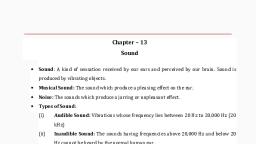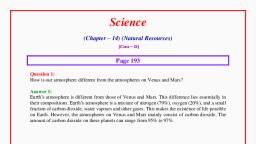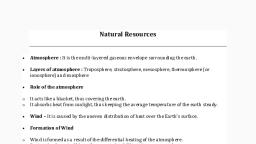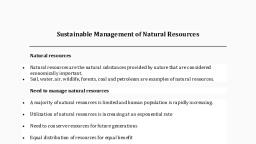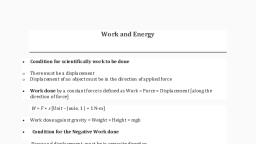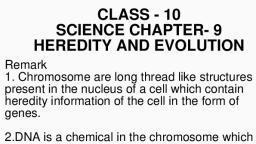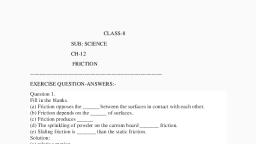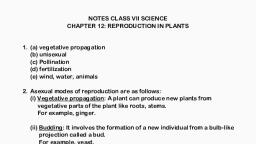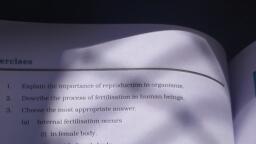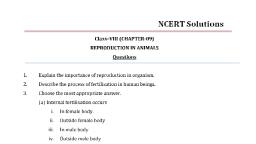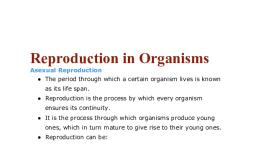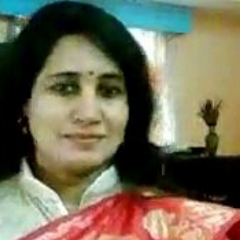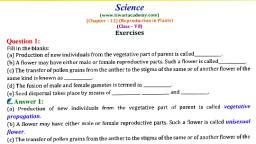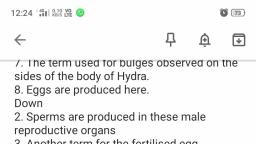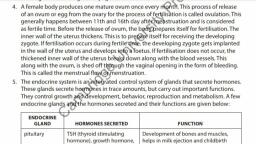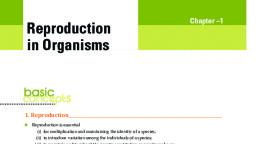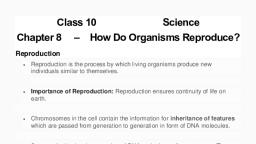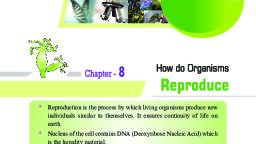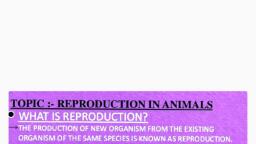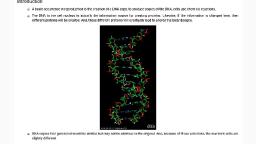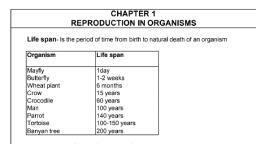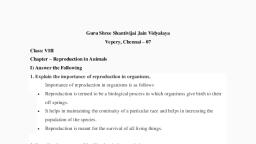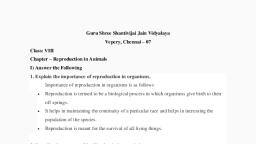Page 1 :
Class 8th, Science, CHP-9, Reproduction in Animals, Definition:Sperms: The testes produce the male gametes called sperms., , Female Reproductive Organs: The female reproductive organs are a pair of, ovaries, oviducts (fallopian tubes) and the uterus.
Page 2 :
Male Reproductive Organs: Male reproductive organs are a pair of testes, sperm ducts,, and a penis., , Ova: Ovary produces females gametes called ova (Egg)., , Binary Fission: In binary fission, a single-celled individual reproduces by dividing itself into, two. Example: Amoeba., Budding: In this type of reproduction, a lateral bud arises from the body’ of the parent, organism, it matures and gets detached from the body to behave as a new organism.
Page 3 :
Eggs: Eggs (or Ova) are female gametes., Embryo: Zygote, during its development, divides repeatedly to form a ball of cells., The cells then form groups to form tissues and ultimately organs of the body. This, structure is called embryo., Fertilization: The fusion of ovum and the sperm is called fertilization., , Question 1., Explain the importance of reproduction in organisms., Answer:, Reproduction is a vital phenomenon on this planet earth which is essential for existence and, continuity of life and species on it, generation after generation., Question 2., Describe the process of fertilisation in human beings., Answer:, In the process of fertilisation, sperms come in contact with an ova (egg). One of the sperms, may fuse with the egg. The nuclei of the sperm and the egg fuse to form a single nucleus, resulting in the formation of a fertilised egg called zygote. In human being, the fertilisation, takes place inside the female body, known as internal fertilisation., Question 3., Choose the most appropriate answer., (a) Internal fertilisation occurs, (i) in female body., (ii) outside female body., (iii) in male body., (iv) outside male body., (b) A tadpole develops into an adult frog by the process of:, (i) fertilisation, (ii) metamorphosis, (iii) embedding, (iv) budding, (c) The number of nuclei present in a zygote is:, (i) none, (ii) one, (iii) two, (iv) four, Answer:, (a) (i), (b) (ii), (c) (ii), , Question 4., Indicate whether the following statements are True (T) or False (F)., 1. Oviparous animals give birth to young ones.
Page 4 :
2. Each sperm is a single cell., 3. External fertilisation takes place in frog., 4. A new human individual develops from a cell called gamete., 5. Egg laid after fertilisation is made up of a single cell., 6. Amoeba reproduces by budding., 7. Fertilisation is necessary even in asexual reproduction., 8. Binary fission is a method of asexual reproduction., 9. A zygote is formed as a result of fertilisation., 10. An embryo is made up of a single cell., , Answer:, 1. False, 2. True, 3. True, 4. False, 5. True, 6. False, 7. False, 8. True, 9. True, 10. False, , 11. Question 5., Give two differences between a zygote and a foetus., Answer:, Zygote, , Foetus, , (i) It is a single celled, i.e., it (i) It is multicelled, i.e., it, contains only one cell., , contains many cells., , (ii) It is formed by the fusion, (ii) It is formed by the, of male gamete or sperm, repeated division of the, and female gamete or ova, zygote., (egg)., , Question 6., Define asexual reproduction. Describe two methods of asexual reproduction in animals., Answer:
Page 5 :
The mode of reproduction in which only a single parent is involved is called asexual, reproduction. In this type of reproduction, sex cells (gametes) are not produced and no, fusion of gametes takes place for the reproduction of zygote or offsprings. Asexual, reproduction takes place in Amoeba, Hydra, yeast, starfish, sponges, etc., There are mainly two methods of asexual reproduction:, (i), , Binary fission: In binary fission, a single parent cell is divided into two, equal individual cells as in Amoeba. It divides into two by division of, their bodies, each of them gets one nucleus and develops into, separate individual. The figure given below shows how binary fission, occurs in Amoeba., , 11. (ii) Budding: In budding, the organism develops a bulge called bud which further, develops into an adult organism and separates itself from the parent body to lead an, independent life. This type of reproduction is shown in Hydra. The following figure, shows budding in Hydra., , Question 7., In which female reproductive organ does the embryo get embedded?, Answer:, Uterus
Page 6 :
Question 8., What is metamorphosis? Give examples., Answer:, The transformation of larva into an adult involving sudden and abrupt changes in the, body of an ani¬mal during the life cycle of an invertebrate or amphibian is called, metamorphosis. Example, frog and butterfly., , Question 9., Differentiate between internal fertilisation and external fertilisation., Answer:, Internal Fertilisation, , (i) The fusion of male, , External Fertilisation, , (i) The fusion of male, , gamete or sperm and female gamete and female, gamete or ova occurs inside gamete takes place, the body of a female partner, outside the body of a, such as human beings,, , female partner, such as in, , birds, and mammal., , frog, fish and starfish., , (ii) The female partner lays, , (ii) The female partner, , either fertilised eggs or a, , discharges unfertilised, , fully grown young one., , eggs., , (iii) Offsprings have a high, , (iii) Offsprings have a low, , chance of survival., , chance of survival., , Question 10., Complete the crossword puzzle using the hints given below., Across
Page 7 :
1. The process of the fusion of the gametes., 6. The type of fertilisation in a hen., 7. The term used for bulges observed on the sides of the body of Hydra., 8. Eggs are produced here., Down, 2. Sperms are produced in these male reproductive organs, 3. Another term for the fertilised egg., 4. These animals lay eggs., 5. A type of fission in Amoeba., , Question 11, Differentiate between viviparous and oviparous animals., Ans:Viviparous Animals, , Oviparous Animals, , (a) The animals which give (a) The animals which lay, birth to young ones., , eggs., , (b) E.g., dog, cow, cat., , (b) E.g., frog, butterfly



